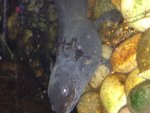Roy
Member
- Joined
- May 2, 2012
- Messages
- 30
- Reaction score
- 0
- Points
- 6
- Location
- Guadalajara, Mexico
- Country
- Mexico
- Display Name
- Roy
Hi everyone, thanks for reading this post.
I have a 2-year-old female Axolotl and I have noticed that their gills have been deteriorating slightly (they have lost a bit of feather but its stem is not shortened). Despite that the animal does not show other signs of disease (enjoys good appetite, there are no fuzzy lesions in their gills, is active and Is not thiny). The water parameters are in good condition except the pH (is in 8). I measured the pH of tap water and also is in 8 and I think my local waters are too hard. Does anyone know if the this pH affects thereby their gills or is another more serious condition? (sorry for my poor English) I will post pics soon. Thanks
I will post pics soon. Thanks
I have a 2-year-old female Axolotl and I have noticed that their gills have been deteriorating slightly (they have lost a bit of feather but its stem is not shortened). Despite that the animal does not show other signs of disease (enjoys good appetite, there are no fuzzy lesions in their gills, is active and Is not thiny). The water parameters are in good condition except the pH (is in 8). I measured the pH of tap water and also is in 8 and I think my local waters are too hard. Does anyone know if the this pH affects thereby their gills or is another more serious condition? (sorry for my poor English)

